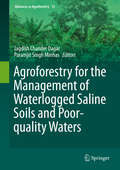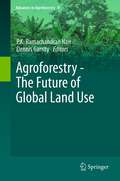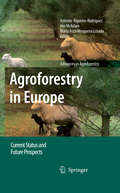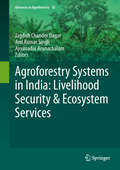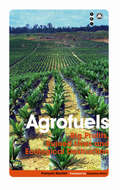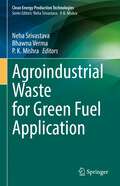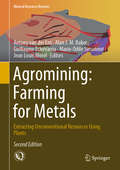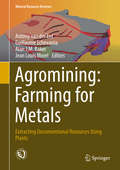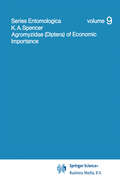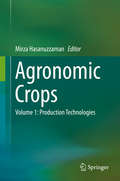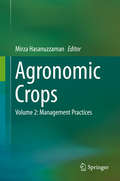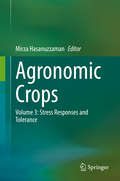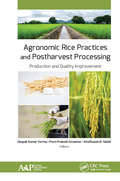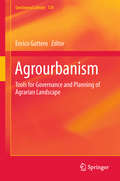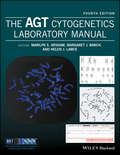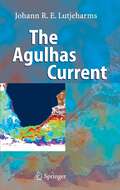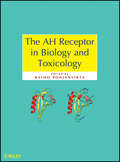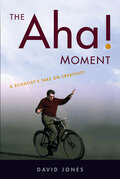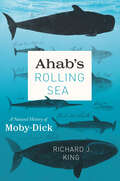- Table View
- List View
Agroforestry for the Management of Waterlogged Saline Soils and Poor-Quality Waters (Advances in Agroforestry #13)
by Jagdish Chander Dagar Paramjit Singh MinhasLand degradation caused by salinity and waterlogging is a global problem afflicting about one billion hectares and endangering the food security of at least 75 countries. Since the social, economic and environmental costs of on and/off-farm reclamation techniques are high, agroforestry is now emerging as a potential tool, not only for arresting salinity and waterlogging, but also for other environmental services like mitigating climate change, sequestering carbon and restoring biodiversity. This publication addresses the vital issues, principles and practices related to rehabilitation using agroforestry and includes many site-specific case studies from a number of the world’s typical catchments. Written by leading researchers, the book is a must, not only for scientists whose research interests lie in soil salinity, waterlogging and poor-quality waters, but also policy makers, environmentalists, students, and educationists alike. More importantly, it contributes to reversing the salinity trends and ensuring the livelihoods of resource-poor farming families living in these harsh agro-ecosystems.
Agroforestry - The Future of Global Land Use (Advances in Agroforestry #9)
by P.K. Ramachandran Nair and Dennis GarrityThis volume contains a solid body of the current state of knowledge on the various themes and activities in agroforestry worldwide. It is organized into three sections: the Introduction section consists of the summaries of six keynote speeches at the 2nd World Congress of Agroforestry held in Nairobi, Kenya, in 2009; that is followed by two sections of peer-reviewed thematic chapters grouped as “Global Perspectives” (seven chapters) and “Regional Perspectives” (eleven chapters), authored by professional leaders in their respective agroforestry-related fields worldwide. A total of 130 professionals from institutions in 33 countries in both developing and the industrialized temperate regions of the world contributed to the book as chapter authors and/or reviewers. Thus, the book presents a comprehensive and authoritative account of the global picture of agroforestry today.
Agroforestry in Europe: Current Status and Future Prospects (Advances in Agroforestry #6)
by Antonio Rigueiro-Rodríguez Jim McAdam María Rosa Mosquera-LosadaAgroforestry has come of age during the past three decades. The age-old practice of growing trees and crops and sometimes animals in interacting combinations – that has been ignored in the single-commodity-oriented agricultural and forestry development paradigms – has been brought into the realm of modern land-use. Today agroforestry is well on its way to becoming a specialized science at a level similar to those of crop science and forestry science. To most land-use experts, however, agroforestry has a tropical connotation. They consider agroforestry as something that can and can only be identified with the tropics. That is a wrong perception. While it is true that the tropics, compared to the temperate regions, have a wider array of agroforestry systems and hold greater promise for potential agroforestry interventions, it is also true that agroforestry has several opportunities in the temperate regions too. Indeed, the role of agroforestry is now recognized in Europe as exemplified by this book, North America, and elsewhere in the temperate zone. Current interest in ecosystem management in industrialized countries strongly suggests that there is a need to embrace and apply agroforestry principles to help mitigate the environmental problems caused or exacerbated by commercial agricultural and forestry production enterprises.
Agroforestry Systems in India: Livelihood Security And Ecosystem Services (Advances in Agroforestry #10)
by Jagdish Chander Dagar Anil Kumar Singh Ayyanadar ArunachalamAgroforestry, the word coined in early seventies, has made its place in all the developed and the developing countries of the world and is now recognized as an important approach to ensuring food security and rebuilding resilient rural environments. India has been an all-time leader in agroforestry. The South and Southeast Asia region comprising India is often described as the cradle of agroforestry. Almost all forms of agroforestry systems exist across India in ecozones ranging from humid tropical lowlands to high-altitude and temperate biomes, and perhumid rainforest zones to parched drylands. The country ranks foremost among the community of nations not only in terms of this enormous diversity and long tradition of the practice of agroforestry, but also in fostering scientific developments in the subject. Agroforestry applies to private agricultural and forest lands and communities that also include highly erodible, flood-prone, economically marginal and environmentally sensitive lands. The typical situation is agricultural, where trees are added to create desired benefits. Agroforestry allows for the diversification of farm activities and makes better use of environmental resources. Owing to an increase in the population of human and cattle, there is increasing demand of food as well as fodder, particularly in developing countries like India. So far, there is no policy that deals with specifics in agroforestry in India. But, the Indian Council of Agricultural Research has been discussing on the scope of having a National Agroforestry Policy in appropriate platforms. However, evolving a policy requires good and reliable datasets from different corners of the country on the subject matter. This synthesis volume containing 13 chapters is an attempt to collate available information in a classified manner into different system ecologies, problems and solutions, and converging them into a policy support.
Agrofuels: Big Profits, Ruined Lives and Ecological Destruction (Transnational Institute)
by François HoutartAgrofuels were heralded as a key weapon in the fight against climate change, but the deforestation and theft of agricultural land that was essential to farmers in the developing world, suggests that they are doing more harm than good.*BR**BR*Francois Houtart argues that the green potential of agrofuels has been hijacked by businesses that put profits above environmental protection. This has led to the absurd situation where an energy source that should be sustainable actually increases human and ecological damage, simply due to the profit-maximising decisions of capitalists rather than a flaw in the concept of agrofuels.*BR**BR*Houtart reveals that we need to rethink neoliberalism's relationship to green politics and ask is capitalism compatible with climate change, or do we need to overhaul our economic system in order to save the planet?
Agroindustrial Waste for Green Fuel Application (Clean Energy Production Technologies)
by Neha Srivastava Bhawna Verma P. K. MishraThe book revisit in depth scope of agroindustrial waste for enhancement in biofuels production on practical ground. It explores and discusses various cellulose rich agro-wastes along with low cost, advance technology based options for sustainable biofuels production. Lignocellulosic biomasses are potential producer of biofuels due to renewable nature and huge occurrence. Cellulose is the main polymeric component of these biomasses apart from lignin and hemicellulose. It can be converted into fermentable sugars using cellulase enzyme which can be further converted into the renewable energy sources such as biohydrogen, bioethanol, biogas and butanol. Chapters in this title provide exclusive and critical analysis of specific biofuels production process only from lignocellulosic biomass, based on their type, property, availability, cost and most important sugar or cellulose content along with the simplest process search for converting these biomasses into biofuels to make overall process more simple and economical.It is a useful guide for academician and environmentalist who are working to explore feasible advantages associated with these kinds of waste management and their effective valorization. It is also a great resource for senior undergraduate and graduate students, researchers, professionals, and other interested individuals/groups working in the field of biofuel/bioenergy.
Agromining: Extracting Unconventional Resources Using Plants (Mineral Resource Reviews)
by Antony van der Ent Alan J. M. Baker Guillaume Echevarria Marie-Odile Simonnot Jean Louis MorelThis second and expanded edition of the first book on agromining (phytomining) presents a comprehensive overview of the metal farming & recovery of the agromining production chain. Agromining is an emerging technology that aims to transform the extraction of sources of target elements not accessible by traditional mining and processing techniques. Agromining, which is based on sustainable development, uses hyperaccumulator plants as 'metal crops' farmed on sub-economic soils or minerals wastes to obtain valuable target elements. This volume is edited and authored by the pioneers in the rapidly expanding field of agromining and presents the latest insights and developments in the field. This book provides in-depth information on the global distribution and ecology of hyperaccumulator plants, their biogeochemical pathways, the influence of rhizosphere microbes, the physiology and molecular biology of hyperaccumulation, as well as aspects of propagation and conservation of these unusual plants. It describes the agronomy of metal crops and opportunities for incorporating agromining into rehabilitation and mine closure, including test cases for agromining of nickel, cobalt, manganese, arsenic, selenium, cadmium, zinc, thallium, rare earth elements and platinum group elements. Since the first edition was published, there have successful nickel agromining field trials in the tropics (in Malaysia and Guatemala), and these are presented in a dedicated case study chapter. Other new chapters focus on the processing of bio-ore for elements other than nickel, such as rare earth elements and cadmium, and on agromining from industrial wastes such as tailings, and industrial by-products and sites. Furthermore, the book features two new chapters that provide a comprehensive assessment of accumulation a very wide range elements from the Periodic Table in various plant species around the globe, and a chapter on practical methods for discovery of hyperaccumulator plant species in the field and in the herbarium. This book is of interest to environmental professionals in the minerals industry, government regulators, and academics.
Agromining: Extracting Unconventional Resources Using Plants (Mineral Resource Reviews)
by Antony van der Ent Guillaume Echevarria Alan J.M. Baker Jean Louis MorelThis is the first book on global agromining/phytomining technology. It presents the complete metal farming or agromining chain; an emerging technology expected to be transformative in the extraction of resources of those elements not accessible by traditional mining techniques. Meeting the demand for critical minerals (rare earth elements, platinum group elements, nickel cobalt) is increasingly difficult in the 21st century due to resource depletion and geopolitical factors. Agromining uses hyperaccumulator plants as “metal crops” farmed on sub-economic soils or mineral waste to obtain valuable elements.This book, which follows the metal farming chain, starts with the latest information on the global distribution and ecology of hyperaccumulator plants, biogeochemical pathways, the influence of rhizosphere microbes, as well as aspects of propagation and conservation of these unusual plants. It then presents the state of the art in new tools for identifying hyperaccumulator plants and for understanding their physiology and molecular biology. It goes on to describe the agronomy of “metal crops,” and opportunities for incorporating agromining into rehabilitation and mine closure, including test-cases of nickel, cobalt, selenium, thallium, rare earth elements and PGEs. Finally, it concludes with an overview of the latest developments in the processing of bio-ores and associated products. This book is edited and authored by the pioneers in the field who have been at the foreground of the development of agromining over the past three decades. It is timely as agromining is now at a pivotal point in its development with rapid expansion of activities in the field around the globe. As such it is of interest to environmental professionals in the minerals industry, government regulators and academics.
Agromyzidae (Series Entomologica #9)
by K.A. SpencerThe original stimulus which started KENNETH SPENCER on a study of the Agro myzid flies was an invitation, which he accepted, to translate from the German the monograph on Leaf Miners by Professor E. M. HERING. From this developed nearly 20 years of collaboration until Professor HERING's death in 1967. Dr. SPENCER has himself described over 600 new species in the family, many of which he collected and reared from known host plants during his extensive travels to all the five main continents. Largely as a result of his work, the number of species known in Britain has increased from 90 in 1945 to 313 today. He is thus uniquely qualified to write this book about the hundred and fifty or so species which are regularly associated with cultivated plants. Much of the taxonomic detail provided here will be of value primarily to specialists; but with the help of a microscope and the botanical host list (Chapter 2) and the numerous illustrations (mostly prepared by ANN SPENCER) those in agri cultural institutes and elsewhere should now be able to identify the majority of species found attacking crops in any part of the world.
Agronomic Crops: Volume 1: Production Technologies
by Mirza HasanuzzamanAgronomic crops have been used to provide foods, beverages, fodders, fuels, medicines and industrial raw materials since the dawn of human civilization. Today, agronomic crops are being cultivated by employing scientific methods instead of traditional methods. However, in the current era of climate change, agronomic crops are subjected to various environmental stresses, which results in substantial yield loss. To meet the food demands of the ever-increasing global population, new technologies and management practices are being adopted to boost yield and maintain productivity under both normal and adverse conditions. Scientists are now exploring a variety of approaches to the sustainable production of agronomic crops, including varietal development, soil management, nutrient and water management, pest management, etc. Researchers have also made remarkable progress in developing stress tolerance in crops through different approaches. However, achieving optimal production to meet the increasing food demand is an open challenge. Although there have been numerous publications on the above-mentioned problems, and despite the extensive research being conducted on them, there is hardly any comprehensive book available. In response, this book offers a timely resource, addressing all aspects of production technologies, management practices and stress tolerance in agronomic crops in a single volume.
Agronomic Crops: Volume 2: Management Practices
by Mirza HasanuzzamanAgronomic crops have provided food, beverages, fodder, fuel, medicine and industrial raw materials since the beginning of human civilization. More recently, agronomic crops have been cultivated using scientific rather than traditional methods. However, in the current era of climate change, agronomic crops are suffering from different environmental stresses that result in substantial yield loss. To meet the food demands of the ever-increasing global population, new technologies and management practices are being adopted to boost yields and maintain productivity under both normal and adverse conditions. Further, in the context of sustainable agronomic crop production, scientists are adopting new approaches, such as varietal development, soil management, nutrient and water management, and pest management. Researchers have also made remarkable advances in developing stress tolerance in crops. However, the search for appropriate solutions for optimal production to meet the increasing food demand is still ongoing. Although there are several publications on the recent advances in these areas, there are few comprehensive resources available covering all of the recent topics. This timely book examines all aspects of production technologies, management practices and stress tolerance of agronomic crops.
Agronomic Crops: Volume 3: Stress Responses and Tolerance
by Mirza HasanuzzamanAgronomic crops have been a source of foods, beverages, fodders, fuels, medicines and industrial raw materials since the dawn of human civilization. Over time, these crops have come to be cultivated using scientific methods instead of traditional methods. However, in the era of climate change, agronomic crops are increasingly subjected to various environmental stresses, which results in substantial yield loss. To meet the food demands of the ever-increasing global population, new technologies and management practices are being adopted to boost yield and maintain productivity under both normal and adverse conditions. To promote the sustainable production of agronomic crops, scientists are currently exploring a range of approaches, which include varietal development, soil management, nutrient and water management, pest management etc. Researchers have also made remarkable progress in developing stress tolerance in crops through various approaches. However, finding solutions to meet the growing food demands remains a challenge. Although there are several research publications on the above-mentioned problems, there are virtually no comprehensive books addressing all of the recent topics. Accordingly, this book, which covers all aspects of production technologies, management practices, and stress tolerance of agronomic crops in a single source, offers a highly topical guide.
Agronomic Rice Practices and Postharvest Processing: Production and Quality Improvement
by Deepak Kumar Verma Prem Prakash Srivastav Altafhusain B. NadafThis volume addresses three important agricultural aspects of rice: physical characteristics, physico-chemical characteristics, and the organoleptic aspects. Divided into sections, the book first examines recent trends and advances for higher production and quality improvement, focusing on the effects of climate on rice cultivation and climate-resilient agricultural practices in rice. The volume goes on to cover nutrient management for rice production and quality improvement. Chapters also address weed management and postharvest processing practices for improved rice production. With chapters from renowned scientists, researchers, and professors, this book will be a useful reference for rice researchers working in the area of agronomic practices, postharvest processing, and quality improvement in rice.
Agronomic Rice Practices and Postharvest Processing: Production and Quality Improvement
by Deepak Kumar Verma Prem Prakash Srivastav Altafhusain B. NadafThis volume addresses three important agricultural aspects of rice: physical characteristics, physico-chemical characteristics, and the organoleptic aspects. Divided into sections, the book first examines recent trends and advances for higher production and quality improvement, focusing on the effects of climate on rice cultivation and climate-resilient agricultural practices in rice. The volume goes on to cover nutrient management for rice production and quality improvement. Chapters also address weed management and postharvest processing practices for improved rice production. With chapters from renowned scientists, researchers, and professors, this book will be a useful reference for rice researchers working in the area of agronomic practices, postharvest processing, and quality improvement in rice.
Agrourbanism: Tools for Governance and Planning of Agrarian Landscape (GeoJournal Library #124)
by Enrico GotteroThis book provides a much needed overview of the agrourbanism topic in the context of territorial studies. It carefully looks at rural, urban, periurban farming in both professional and unprofessional capacities as one of the main sustainable forms of land use and management. This cutting edge text explores the various forms of agricultural and urban planning, as well as the main innovations that the agro-urban approach entails in terms of governance, spatial dimensions and functions. Agrourbanism provides a breadth of information and serves as a practical study of concerns facing policy and decision makers, planners and landscape managers, as well as farmers, managers of protected areas, local authorities and local action groups. As such this book is suitable as a course accompaniment to provide an overview of the complexity of agro-urban issues.
The AGT Cytogenetics Laboratory Manual
by Marilyn Arsham Helen J. Lawce Margaret J. BarchCytogenetics is the study of chromosome morphology, structure, pathology, function, and behavior. The field has evolved to embrace molecular cytogenetic changes, now termed cytogenomics. Cytogeneticists utilize an assortment of procedures to investigate the full complement of chromosomes and/or a targeted region within a specific chromosome in metaphase or interphase. Tools include routine analysis of G-banded chromosomes, specialized stains that address specific chromosomal structures, and molecular probes, such as fluorescence in situ hybridization (FISH) and chromosome microarray analysis, which employ a variety of methods to highlight a region as small as a single, specific genetic sequence under investigation. The AGT Cytogenetics Laboratory Manual, Fourth Edition offers a comprehensive description of the diagnostic tests offered by the clinical laboratory and explains the science behind them. One of the most valuable assets is its rich compilation of laboratory-tested protocols currently being used in leading laboratories, along with practical advice for nearly every area of interest to cytogeneticists. In addition to covering essential topics that have been the backbone of cytogenetics for over 60 years, such as the basic components of a cell, use of a microscope, human tissue processing for cytogenetic analysis (prenatal, constitutional, and neoplastic), laboratory safety, and the mechanisms behind chromosome rearrangement and aneuploidy, this edition introduces new and expanded chapters by experts in the field. Some of these new topics include a unique collection of chromosome heteromorphisms; clinical examples of genomic imprinting; an example-driven overview of chromosomal microarray; mathematics specifically geared for the cytogeneticist; usage of ISCN’s cytogenetic language to describe chromosome changes; tips for laboratory management; examples of laboratory information systems; a collection of internet and library resources; and a special chapter on animal chromosomes for the research and zoo cytogeneticist. The range of topics is thus broad yet comprehensive, offering the student a resource that teaches the procedures performed in the cytogenetics laboratory environment, and the laboratory professional with a peer-reviewed reference that explores the basis of each of these procedures. This makes it a useful resource for researchers, clinicians, and lab professionals, as well as students in a university or medical school setting.
The AGT Cytogenetics Laboratory Manual
by Marilyn S. Arsham Margaret J. Barch Helen J. LawceCytogenetics is the study of chromosome morphology, structure, pathology, function, and behavior. The field has evolved to embrace molecular cytogenetic changes, now termed cytogenomics. Cytogeneticists utilize an assortment of procedures to investigate the full complement of chromosomes and/or a targeted region within a specific chromosome in metaphase or interphase. Tools include routine analysis of G-banded chromosomes, specialized stains that address specific chromosomal structures, and molecular probes, such as fluorescence in situ hybridization (FISH) and chromosome microarray analysis, which employ a variety of methods to highlight a region as small as a single, specific genetic sequence under investigation. The AGT Cytogenetics Laboratory Manual, Fourth Edition offers a comprehensive description of the diagnostic tests offered by the clinical laboratory and explains the science behind them. One of the most valuable assets is its rich compilation of laboratory-tested protocols currently being used in leading laboratories, along with practical advice for nearly every area of interest to cytogeneticists. In addition to covering essential topics that have been the backbone of cytogenetics for over 60 years, such as the basic components of a cell, use of a microscope, human tissue processing for cytogenetic analysis (prenatal, constitutional, and neoplastic), laboratory safety, and the mechanisms behind chromosome rearrangement and aneuploidy, this edition introduces new and expanded chapters by experts in the field. Some of these new topics include a unique collection of chromosome heteromorphisms; clinical examples of genomic imprinting; an example-driven overview of chromosomal microarray; mathematics specifically geared for the cytogeneticist; usage of ISCN’s cytogenetic language to describe chromosome changes; tips for laboratory management; examples of laboratory information systems; a collection of internet and library resources; and a special chapter on animal chromosomes for the research and zoo cytogeneticist. The range of topics is thus broad yet comprehensive, offering the student a resource that teaches the procedures performed in the cytogenetics laboratory environment, and the laboratory professional with a peer-reviewed reference that explores the basis of each of these procedures. This makes it a useful resource for researchers, clinicians, and lab professionals, as well as students in a university or medical school setting.
The Agulhas Current
by Johann R.E. LutjeharmsBased on the research findings of 60 years, the author describes the origins of the Agulhas Current, its behaviour, its influence on the adjacent continental shelf, its effect on local weather and its role in linking the Indian and Atlantic Oceans. The text is well-illustrated and includes asides on the history of research on the Current. An exhaustive bibliography gives easy access to present knowledge on this important current system.
The AH Receptor in Biology and Toxicology
by Raimo PohjanvirtaThis book provides a thorough and up-to-date overview of the aryl hydrocarbon receptor (AHR) and its unique dual role in toxicology and biology. The coverage includes epigenetic mechanisms, gene expression, reproductive and developmental toxicity, signal transduction, and transgenic animal models. Featuring an internationally recognized team of authors at the forefront of AHR research, this resource provides a comprehensive reference for readers interested in understanding the full spectrum of AHR, from basic concepts, toxicology analysis, and models to polymorphism and related diseases.
The AH Receptor in Biology and Toxicology
by Raimo PohjanvirtaThis book provides a thorough and up-to-date overview of the aryl hydrocarbon receptor (AHR) and its unique dual role in toxicology and biology. The coverage includes epigenetic mechanisms, gene expression, reproductive and developmental toxicity, signal transduction, and transgenic animal models. Featuring an internationally recognized team of authors at the forefront of AHR research, this resource provides a comprehensive reference for readers interested in understanding the full spectrum of AHR, from basic concepts, toxicology analysis, and models to polymorphism and related diseases.
The Aha! Moment: A Scientist's Take on Creativity
by David JonesThis book is about having ideas and—a much longer haul—making them work. David Jones, best known for his Daedalus column, tells a multitude of stories about creators and their creations, including his own fantastical-seeming contributions to mainstream science such as the unrideable bicycle and chemical gardens in space. His theory of creativity endows each of us with a Random-Ideas Generator, a Censor, and an Observer-Reasoner. Jones applies his theory to a wide range of weird scientific experiments that he has conducted for serious scientific papers, for challenging printed expositions, and for presentations to a TV audience. He even suggests new ones, not yet tried! Creativity is as essential to science as curiosity, physical intuition, and shrewd deduction from well-planned experiments. But, says Jones, ingenuity is very uncertain. Even for the greatest inventors, about 80 percent of ideas fail. Jokiness can help, and so can lots of random data. Jones has plenty of clever advice that will help spark that madly brilliant private thought in the first place—and will encourage you to take it further.Neither dense nor demanding, The Aha! Moment is engrossing, edifying, and scientifically serious; yet it is lightly written and asks lots of silly questions. As Jones shows, it can often pay to take an absurd idea seriously.
The Aha! Moment: A Scientist's Take on Creativity
by David JonesThis book is about having ideas and—a much longer haul—making them work. David Jones, best known for his Daedalus column, tells a multitude of stories about creators and their creations, including his own fantastical-seeming contributions to mainstream science such as the unrideable bicycle and chemical gardens in space. His theory of creativity endows each of us with a Random-Ideas Generator, a Censor, and an Observer-Reasoner. Jones applies his theory to a wide range of weird scientific experiments that he has conducted for serious scientific papers, for challenging printed expositions, and for presentations to a TV audience. He even suggests new ones, not yet tried! Creativity is as essential to science as curiosity, physical intuition, and shrewd deduction from well-planned experiments. But, says Jones, ingenuity is very uncertain. Even for the greatest inventors, about 80 percent of ideas fail. Jokiness can help, and so can lots of random data. Jones has plenty of clever advice that will help spark that madly brilliant private thought in the first place—and will encourage you to take it further.Neither dense nor demanding, The Aha! Moment is engrossing, edifying, and scientifically serious; yet it is lightly written and asks lots of silly questions. As Jones shows, it can often pay to take an absurd idea seriously.
Ahab's Rolling Sea: A Natural History of "Moby-Dick"
by Richard J. KingAlthough Herman Melville’s Moby-Dick is beloved as one of the most profound and enduring works of American fiction, we rarely consider it a work of nature writing—or even a novel of the sea. Yet Pulitzer Prize–winning author Annie Dillard avers Moby-Dick is the “best book ever written about nature,” and nearly the entirety of the story is set on the waves, with scarcely a whiff of land. In fact, Ishmael’s sea yarn is in conversation with the nature writing of Emerson and Thoreau, and Melville himself did much more than live for a year in a cabin beside a pond. He set sail: to the far remote Pacific Ocean, spending more than three years at sea before writing his masterpiece in 1851. A revelation for Moby-Dick devotees and neophytes alike, Ahab’s Rolling Sea is a chronological journey through the natural history of Melville’s novel. From white whales to whale intelligence, giant squids, barnacles, albatross, and sharks, Richard J. King examines what Melville knew from his own experiences and the sources available to a reader in the mid-1800s, exploring how and why Melville might have twisted what was known to serve his fiction. King then climbs to the crow’s nest, setting Melville in the context of the American perception of the ocean in 1851—at the very start of the Industrial Revolution and just before the publication of On the Origin of Species. King compares Ahab’s and Ishmael’s worldviews to how we see the ocean today: an expanse still immortal and sublime, but also in crisis. And although the concept of stewardship of the sea would have been entirely foreign, if not absurd, to Melville, King argues that Melville’s narrator Ishmael reveals his own tendencies toward what we would now call environmentalism. Featuring a coffer of illustrations and an array of interviews with contemporary scientists, fishers, and whale watch operators, Ahab’s Rolling Sea offers new insight not only into a cherished masterwork and its author but also into our evolving relationship with the briny deep—from whale hunters to climate refugees.
Ahab's Rolling Sea: A Natural History of "Moby-Dick"
by Richard J. KingAlthough Herman Melville’s Moby-Dick is beloved as one of the most profound and enduring works of American fiction, we rarely consider it a work of nature writing—or even a novel of the sea. Yet Pulitzer Prize–winning author Annie Dillard avers Moby-Dick is the “best book ever written about nature,” and nearly the entirety of the story is set on the waves, with scarcely a whiff of land. In fact, Ishmael’s sea yarn is in conversation with the nature writing of Emerson and Thoreau, and Melville himself did much more than live for a year in a cabin beside a pond. He set sail: to the far remote Pacific Ocean, spending more than three years at sea before writing his masterpiece in 1851. A revelation for Moby-Dick devotees and neophytes alike, Ahab’s Rolling Sea is a chronological journey through the natural history of Melville’s novel. From white whales to whale intelligence, giant squids, barnacles, albatross, and sharks, Richard J. King examines what Melville knew from his own experiences and the sources available to a reader in the mid-1800s, exploring how and why Melville might have twisted what was known to serve his fiction. King then climbs to the crow’s nest, setting Melville in the context of the American perception of the ocean in 1851—at the very start of the Industrial Revolution and just before the publication of On the Origin of Species. King compares Ahab’s and Ishmael’s worldviews to how we see the ocean today: an expanse still immortal and sublime, but also in crisis. And although the concept of stewardship of the sea would have been entirely foreign, if not absurd, to Melville, King argues that Melville’s narrator Ishmael reveals his own tendencies toward what we would now call environmentalism. Featuring a coffer of illustrations and an array of interviews with contemporary scientists, fishers, and whale watch operators, Ahab’s Rolling Sea offers new insight not only into a cherished masterwork and its author but also into our evolving relationship with the briny deep—from whale hunters to climate refugees.
Ahab's Rolling Sea: A Natural History of "Moby-Dick"
by Richard J. KingAlthough Herman Melville’s Moby-Dick is beloved as one of the most profound and enduring works of American fiction, we rarely consider it a work of nature writing—or even a novel of the sea. Yet Pulitzer Prize–winning author Annie Dillard avers Moby-Dick is the “best book ever written about nature,” and nearly the entirety of the story is set on the waves, with scarcely a whiff of land. In fact, Ishmael’s sea yarn is in conversation with the nature writing of Emerson and Thoreau, and Melville himself did much more than live for a year in a cabin beside a pond. He set sail: to the far remote Pacific Ocean, spending more than three years at sea before writing his masterpiece in 1851. A revelation for Moby-Dick devotees and neophytes alike, Ahab’s Rolling Sea is a chronological journey through the natural history of Melville’s novel. From white whales to whale intelligence, giant squids, barnacles, albatross, and sharks, Richard J. King examines what Melville knew from his own experiences and the sources available to a reader in the mid-1800s, exploring how and why Melville might have twisted what was known to serve his fiction. King then climbs to the crow’s nest, setting Melville in the context of the American perception of the ocean in 1851—at the very start of the Industrial Revolution and just before the publication of On the Origin of Species. King compares Ahab’s and Ishmael’s worldviews to how we see the ocean today: an expanse still immortal and sublime, but also in crisis. And although the concept of stewardship of the sea would have been entirely foreign, if not absurd, to Melville, King argues that Melville’s narrator Ishmael reveals his own tendencies toward what we would now call environmentalism. Featuring a coffer of illustrations and an array of interviews with contemporary scientists, fishers, and whale watch operators, Ahab’s Rolling Sea offers new insight not only into a cherished masterwork and its author but also into our evolving relationship with the briny deep—from whale hunters to climate refugees.
